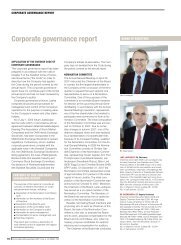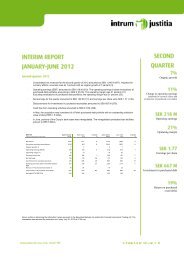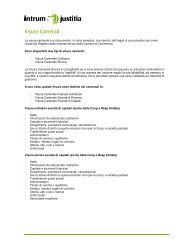ANNUAL REPORT INTRUM JUSTITIA A N N U A L R EP O R T 2 0 ...
ANNUAL REPORT INTRUM JUSTITIA A N N U A L R EP O R T 2 0 ...
ANNUAL REPORT INTRUM JUSTITIA A N N U A L R EP O R T 2 0 ...
Create successful ePaper yourself
Turn your PDF publications into a flip-book with our unique Google optimized e-Paper software.
28 <strong>EP</strong>I 2010<br />
European Payment Index (<strong>EP</strong>I) 2010<br />
– on the right path<br />
Since 1998 Intrum Justitia has conducted an annual survey of changes in payment<br />
behavior in Europe. The results are used to gain a better understanding<br />
of how European companies view payment behavior in their country and<br />
how an entire nation’s economy is negatively affected by late payments.<br />
The 2010 survey revealed that many of the 3,900 or so small<br />
and medium-sized enterprises included in the survey are<br />
still having financial problems, despite political pledges<br />
about recovery. European banks are still cautious in granting<br />
credit, which is mainly affecting small businesses.<br />
The increasing percentage of bankruptcies in 2009 in Europe<br />
gave rise to an increase in write-downs. In 2009 169,000 European<br />
companies filed for bankruptcy. The European Commission’s small<br />
and medium-sized enterprises section predicted that this figure<br />
would grow to 200,000 in 2010, which represents an increase of<br />
18 percent. The unwillingness of banks to extend more credit to<br />
small and medium-sized enterprises is probably driving this trend.<br />
SLOW RECOVERY<br />
Despite the fact that growth in Europe is modest, there are signs<br />
today of a slow recovery in several European countries. The conclusion<br />
from the European Payment Index is that the late payment<br />
situation has stabilized since 2009, but that the future for European<br />
businesses is still uncertain. In the countries hit the hardest<br />
by the financial crisis in 2008 and 2009, there are still few signs of<br />
improvement in terms of getting paid on time for products and<br />
services. Pessimism is highest among companies in the countries<br />
hit the hardest by the financial crisis.<br />
SHORTER LATE PAYMENT PERIODS<br />
BUT INCREASE IN WRITTEN-Off RECEIVABLES<br />
One piece of good news from the 2010 <strong>EP</strong>I is that the average late<br />
payment period for payments in Europe, i.e. the period after an<br />
invoice falls due for payment, has gone down by one day, from 19<br />
NO. OF<br />
DAYS<br />
15.1<br />
16.3 16.8<br />
16.0<br />
17.0<br />
04 05 06 07 08 09 10<br />
LATE PAYMENT IN EUROPE,<br />
average<br />
19.0<br />
18.0<br />
days in 2009 to 18 days in 2010. This means that companies are<br />
waiting for a shorter period for payment compared to just over a<br />
year ago. This good news is counteracted by the fact that the average<br />
percentage of receivables that are written off has risen to 2.6 percent,<br />
from 2.4 percent the previous year – a figure that was 1.9 percent<br />
in 2007. This means that the percentage of invoices that are never<br />
paid and ultimately written off has increased every year since 2007.<br />
Somewhat surprisingly, companies tend to react slowly when it<br />
comes to handling late payments. Despite the obvious drawback of<br />
getting paid late or not at all, close to 65 percent of companies wait<br />
an average of 85 days before sending a case to a credit management<br />
company.<br />
BETTER LEGISLATION IS NEEDED<br />
Outside the Nordic countries most respondents in the survey want<br />
better legislation to enable them to collect reminder fees and penalty<br />
interest as this is difficult when it is not the normal practice in<br />
their country. In the Nordic region this is supported by local regulations<br />
and payment patterns here are much healthier compared<br />
with countries in, for example, Southern Europe.<br />
An obvious consequence of late payments is lost income and<br />
lower liquidity for companies. This, combined with a lack of confidence<br />
that banks will provide businesses with financial support<br />
to generate growth, makes for a challenging situation for many<br />
small and medium-sized enterprises. The results of the European<br />
Payment Index emphasize the need for better credit management<br />
by many European companies. Analyzing the creditworthiness of<br />
prospective clients and thereby being able to offer several payment<br />
options is a step in the right direction.<br />
€<br />
€<br />
€<br />
1.7% 1.9% 1.8%<br />
04 05 06 07 08 09 10<br />
CREDIT LOSSES IN EUROPE,<br />
average<br />
1.9% 2.0% 2.4% 2.6%<br />
PERCENTAGE OF<br />
TOTAL TURNOVER
















